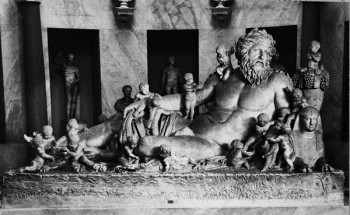American Journal of Archaeology | The Journal of the Archaeological Institute of America
You are here
Egypt Embodied: The Vatican Nile
July 2009 (113.3)
Egypt Embodied: The Vatican Nile
The Vatican Nile, a monumental marble sculpture once displayed in Rome’s Iseum Campense with a companion Tiber, has had a rich post-Antique afterlife. Long in the collections of the Vatican, both sculptures were taken as spolia to Paris in 1797. Only the Nile returned to Rome. Though long understood as pendants, their physical divorce created a scholarly tradition that treats the Vatican Nile primarily in isolation, as the classic example of a broader sculptural type. The present article shifts the line of inquiry to an exploration of the multiple meanings of the artwork in its immediate and topographical surroundings, within the Iseum and Serapeum and the Campus Martius. It offers a reading of the pair of Nile and Tiber that takes into account the decoration of their bases, sculpted on all four sides, arguing that the works were intended to be seen in the round. The bases below and personifications above juxtaposed different visual conventions for depicting landscapes and their denizens, deliberately bringing together traditions about the founding of Rome and the place of Egypt in the empire.
Egypt Embodied: The Vatican Nile
By Molly Swetnam-Burland
American Journal of Archaeology Vol. 113, No. 3 (July 2009), pp. 439–457
DOI: 10.3764/aja.113.3.439
© 2009 Archaeological Institute of America


